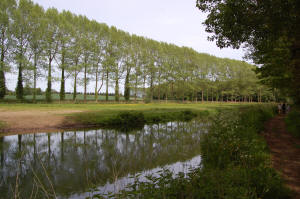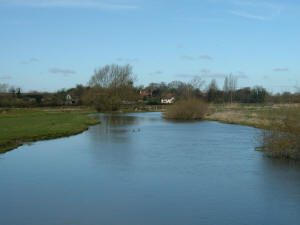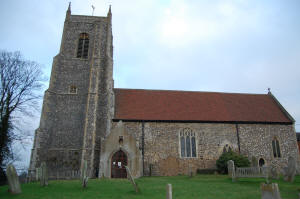The River Bure
The River Bure rises in North Norfolk - with
tributaries converging from Melton Constable, Matlaske
and Felbrigg. It flows in a south-easterly direction
towards Great
Yarmouth and the North Sea. It is one of the
county's largest rivers and becomes navigable at
Coltishall.
It then flows through the busy holiday resorts of
Wroxham and
Horning before merging with
the River Thurne close to the village of Thurne. In its
final stretch, it meanders its way across the Halvergate
Marshes before joining the
River Yare at the tip of Breydon Water.

River Bure near Oxnead Hall
The Bure has many literary connections. In its upper
reaches, it flows through the village of
Itteringham where the poet
George Barker lived with his wife (the novelist) Elspeth
Barker. Their flint and brick cottage stood close to the
river and inspired him to write the following lines in
his poem poem
Morning in Norfolk:
|
The dawn has brightened the
shallows and shadows and
the Bure sidles and idles
through weed isles and fallen
willows, and under
Itteringham Mill, and
there is a kind of rain-
drenched flittering in the
air, the night swan still
sleeps in her wings and over it all
the dawn heaps up the hanging
fire of the day. |
|
Further downstream, the Bure flows past
Oxnead Hall -
one-time home of the Paston family - where the Paston
Letters were discovered. Only one wing of the original
hall still stands but the house has been extensively
rebuilt. At nearby Brampton, the discovery of some Roman
urns inspired Sir Thomas
Browne to write an antiquary's piece entitled:
Concerning some urnes found in Brampton feild in Norfolk.
The Bure then passes
through the villages of Buxton
and Lamas -
which both have connections with Anna Sewell - the
author of Black Beauty. Anna Sewell found
inspiration for the Birtwick Park in her novel from
Dudwick Park in Buxton - a farm owned by her
grandparents; it was here that she first learned to
ride. She was buried in the graveyard of the Quaker
Chapel at Lamas and, today, her gravestone has been set
into the wall by the roadside. (The chapel is now a
privately owned home.)

River Bure at Brampton
One of Sir John Betjeman's favourite Norfolk Churches
was St. Peter's at Belaugh - which lies
on a steep hill overlooking the river. In fact, it was
St. Peter's which provided the inspiration for his life-long
interest in church-crawling. He first encountered it
when he came to Norfolk on family holidays.

St Peter's Church at
Belaugh
Betjeman (1906-1984) also mentions the Bure in his
moving poem Norfolk - recalling
both his father and his memories of the county:
|
There after supper lit by lantern light
Warm in the cabin I could lie secure
And hear against the polished sides at night
The lap lapping of the weedy Bure,
A whispering and watery Norfolk sound
Telling of all the moonlit reeds around.
Read complete poem |
The Bure is also the central location for
Arthur Ransome's children's adventure stories Coot Club
(1934) and The Big Six (1940). The staithe at
Horning provides the starting point for both of these
novels and both stories employ a plot connected with
casting boats adrift from their moorings. In Coot
Club Dick and Dorothea sail up and down the Bure
several times and visit Ranworth and South Walsham
Broads and pass St. Benet's Abbey on their way to
Potter Heigham.
|
|

St. Benet's Abbey
|
In Coot Club Dick, Dorothea,
Tom and Mrs Barrable have to take the mast of the
Teasel down in order to get through Acle bridge.
Once they've negotiated the bridge they head for
Stokesby and Great Yarmouth.
|
|
'Mile after mile the Teasel and the Titmouse
flew down those dreary lower reaches of the Bure.
Windmills slipped by one after another, and the rare
houses called by their distance out of Yarmouth,
"Six-Mile House," "Five-Mile House," and so on. And
still the ebb was pouring down, and the mud was widening
on either side of the channel. Were they going to reach
Yarmouth too soon?' |
Another author who found inspiration from the river was
C. P. Snow (1905-1980). His murder mystery Death
Under Sail (1932) is set on a wherry which sails
down the Bure from Wroxham. The skipper of the wherry is
shot dead at the wheel and the case is taken up by the
Norfolk investigator Aloysius Birrell.
|
Links:
More River Bure Photographs
|

